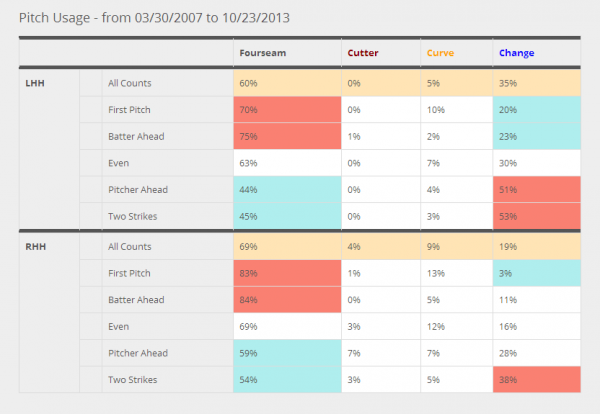Player-A-Day: Michael Wacha
Welcome to Player-A-Day. The purpose of this column is to identify interesting major league players who may be fantasy relevant in 2014. We will discuss the real world roles that the player may fill, set a range of potential expectations, identify any wild card factors in play, and comment on how this affects the player’s fantasy value.
The high level
An incredible postseason run has all but assured Michael Wacha of a prominent role in the Cardinals 2014 rotation. Over his first four playoff appearances, he’s allowed just 11 hits and nine walks in 27 innings. Two home runs have accounted for the only three runs he’s allowed, and he was named the NLCS MVP.
His postseason burst includes a leap in his fastball velocity that will be worth watching in 2014. If that represents a new normal for him, it may be the difference between a great pitcher and an elite pitcher.
There is no question about his role in 2014, but there is some small reason to be concerned about injury. It’s fairly common to see young pitchers reach the majors, excel briefly, and then lose the velocity that helped them to succeed. That dreaded dip in velocity could be accompanied by elbow or shoulder injuries, but all of these issues are incredibly difficult to predict. Treat Wacha as you would any young, healthy pitcher—just be aware of the risks.
Let’s not mince words, Wacha should be rostered in every league.
The details
This is a pitcher who has the swing-and-miss stuff to strike out a batter per inning, limit walks with advanced command and control, all while generating a healthy volume of ground balls. In essence, Wacha is an ideal starting pitcher in both the real and fantasy sense.
Wacha has a big fastball that he controls well and uses to set up his bread and butter – a filthy changeup that generates a 22 percent whiff rate and plenty of ground balls. While the change-up isn’t as visually stunning as that of Cole Hamels or Johan Santana, it’s very nearly as lethal to hitters.
Sticking with the Hamels comp for a moment, Wacha doesn’t have the same elite command and control of the change-up. Like Hamels’, Wacha’s change-up generates a high volume of swings; basically the hitter’s mind says “Cookie!” and jumps at the pitch prematurely. But Wacha’s change-up is called for a ball 10 percent more frequently.
If one wanted to find something in Wacha’s profile over which to quibble, it would be his breaking ball. He’s thrown his curve just 6.77 percent of the time. It’s a show-me pitch that he uses to catch hitters off guard. The curve is usually a high whiff pitch, but Wacha musters only a 7.78 percent whiff rate. Interestingly, he’s been using the pitch more frequently in the postseason which may be a harbinger of things to come.
Wacha also pitches “forward” which is unusual for change-up pitchers. Pitching forward isn’t really a recognized pitching term—it’s kind of like saying that I’m gruntled to indicate satisfaction. As you can imagine, pitching forward is the opposite of pitching backward which refers to throwing unexpected pitches; i.e. a change-up in a 2-0 count. Let’s illustrate (charts are from Brooksbaseball.net).

As you can see from the cell highlighting, Wacha likes to get ahead with fastballs, then goes to the change-up for the finish. This is intuitive; he gets ahead of the hitter and then tries for the strikeout with his best whiff-inducing pitch. But it’s also predictable. Here’s that same chart for Hamels.

Notice the lack of cell highlighting. Hamels does his best to remain utterly unpredictable, which helps keep the sit-and-rip type hitters off his change-up.
I expect Wacha to begin mixing his pitch distributions more in 2014. It’s a simple adjustment that should reap immediate benefits.
Fantasy implications
We have established that Wacha is good and that postseason success will push him up draft boards. How high should you be willing to take him?
Let’s start by guestimating an FIP. Conservatively, we can expect regression in his home run, strikeout, and walk rates. In plain English, that means more home runs, fewer strikeouts, and more walks. Based on watching him pitch and perusing his stats, there’s plenty of room for Wacha to improve on his 2013 raw performance. Please note, that’s not the same as saying that he’ll improve on his 2.92 FIP since that includes a slightly depressed home run rate.
I thought Matt Harvey would serve as a reasonable starting point, mostly because I witnessed him get drafted in the third round of a linear weights league. But according to Fantasy Pros, he was drafted as the 57th pitcher behind Brett Anderson (whoops). If Wacha had bombed in the postseason, then this comp might have worked, but I think we have to throw it out.
Since it’s so early in the fantasy offseason, let’s not worry about precision. Using that same list linked above, I expect Wacha to be better than the 2013 expectations for James Shields and Mat Latos. I expect him to be worse than what I thought Adam Wainwright and Madison Bumgarner would produce. That leaves us with a rough estimate between the 15th and 23rd pitcher off the board. In most standard auctions, that’s in the area of $20.
Given that pitchers like Sonny Gray and Danny Salazar will likely be nearly as effective for a fraction of the cost, it might be wise to pass on Wacha. Still at around $20, he has plenty of opportunity to return value to your team. Just remember that young pitching is inherently volatile.
